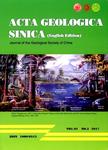Miocene Tectonic Evolution from Dextral-Slip Thrusting to Extension in the Nyainqentanglha Region of the Tibetan Plateau
Miocene Tectonic Evolution from Dextral-Slip Thrusting to Extension in the Nyainqentanglha Region of the Tibetan Plateau作者机构:Institute of Geomechanics Chinese Academy of Geological Sciences Beijing 100081 China P. J. Barosh 103 Aaron Avenue Bristol RI 02809 USA Chinese Academy of Geological Sciences Beijing 100037 China
出 版 物:《Acta Geologica Sinica(English Edition)》 (地质学报(英文版))
年 卷 期:2007年第81卷第3期
页 面:365-384页
核心收录:
学科分类:070903[理学-古生物学与地层学(含:古人类学)] 0709[理学-地质学] 07[理学]
基 金:科技部科研项目(DKD9901001 2001CB711001) 中国地质科学院地质力学研究所资助项目 中国地质调查局资助项目
主 题:Miocene tectonics strike-slip fault thrust fault extensional tectonic system uplift graniteplutonism Nyainqentanglha region Tibetan Plateau
摘 要:Dextral-slip in the Nyainqentanglha region of Tibet resulted in oblique underthrusting and granite generation in the Early to Middle Miocene, but by the end of the epoch uplift and extensional faulting dominated. The east-west dextral-slip Gangdise fault system merges eastward into the northeast-trending, southeast-dipping Nyainqentanglha thrust system that swings eastward farther north into the dextral-slip North Damxung shear zone and Jiali faults. These faults were took shape by the Early Miocene, and the large Nyainqentanglha granitic batholith formed along the thrust system in 18.3-11.0 Ma as the western block drove under the eastern one. The dextral-slip movement ended at -11 Ma and the batholith rose, as marked by gravitational shearing at 8.6-8.3 Ma, and a new fault system developed. Northwest-trending dextral-slip faults formed to the northwest of the raisen batholith, whereas the northeast-trending South Damxung thrust faults with some sinistral-slip formed to the southeast. The latter are replaced farther to the east by the west-northwest-trending Lhtinzhub thrust faults with dextral-slip. This relatively local uplift that left adjacent Eocene and Miocene deposits preserved was followed by a regional uplift and the initiation of a system of generally north-south grabens in the Late Miocene at -6.5 Ma. The regional uplift of the southern Tibetan Plateau thus appears to have occurred between 8.3 Ma and 6.5 Ma. The Gulu, DamxungYangbajain and Angan graben systems that pass east of the Nyainqentanglha Mountains are locally controlled by the earlier northeast-trending faults. These grabens dominate the subsequent tectonic movement and are still very active as northwest-trending dextral-slip faults northwest of the mountains. The Miocene is a time of great tectonic change that ushered in the modern tectonic regime.



